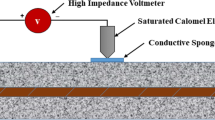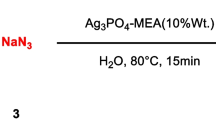Abstract
Electrochemical methods were used to study the characteristics of corrosion process for the high-strength low-alloy steel and carbon steel used as a huge oil storage tank in NaHSO3 solution. The polarization curve results show that both steel samples take place in active solution, and the high-strength low-alloy (HSLA) steel has higher i corr value than carbon steel, which is due to the small grain size that provides high density of active sites for preferential attack. The electrochemical impedance spectroscopy (EIS) results make known that the corrosion process presents two stages. In the first 136 h, one-time constant in EIS diagrams can be shown. Both steels have similar corrosion resistance due to the combination effects of the grain size and microstructure. After 240 h of immersion, a complete passive film forms on the specimen surface, and two-time constants can be shown in EIS diagram. The HSLA steel exhibited improved corrosion resistance when compared with the carbon steel, which is due to the effect of the shape Fe3C in microstructure and the deposition of FeSO4 on the electrode surface. The scanning electrode microscopy analyses show that both steels take place in homogenous corrosion, and the carbon steel shows higher surface roughness and many Fe3C residues. XRD results show that both steels have similar phase constitutes of corrosion products.








Similar content being viewed by others
References
Li DG, Feng YR, Bai ZM et al (2007) Electrochim Acta 52:7877. doi:10.1016/j.electacta.2007.06.059
Choi YS, Shim JJ, Kim JG (2004) Mater Sci Eng A 385:148
Choi YS, Kim JG (2000) Corrosion 56:1202
Alves VA, Bret CMA (2002) Electrochim Acta 47:2081. doi:10.1016/S0013-4686(02) 00077-4
Yang Q, Luo JL (2000) Electrochim Acta 45:3927. doi:10.1016/S0013-4686(00) 00492-8
Martini EMA, Muller IL (2000) Corros Sci 42:443. doi:10.1016/S0010-938X(99) 00064-5
Davies DH, Burstein GT (1980) Corrosion 36:416
Chinese Railway Standard Testing method for corrosivity of industrial gas, TBT2375, 1994, pp 1–6.
Meng GZ, Li Y, Wang FH (2006) Electrochim Acta 51:4277. doi:10.1016/j.electacta.2005.12.015
Christiansen KA, Hoeg H, Michelsen K et al (1961) Acta Chem Scand 15:300. doi:10.3891/acta.chem.scand.15-0300
Bockris JOM, Drazic D, Despic R (1961) Electrochim Acta 4:325. doi:10.1016/0013-4686(61) 80026-1
Albarran JL, Martinez L, Lopez HF (1999) Corros Sci 41:1049. doi:10.1016/S0010-938X(98) 00139-5
Wallinder D, Pan J, Lergraf C et al (1999) Corros Sci 41:275. doi:10.1016/S0010-938X(98) 00122-X
Dugstad A, Hemmer H, Seiersten M (2000) Proceeding of NACA Corrosion NACE 2000, Orlando, p 30
Tan YJ, Bailey S, Kinsella B (1996) Corros Sci 38:1545. doi:10.1016/0010-938X(96) 00047-9
Cao CN, Zhang JQ (2002) An introduction to electrochemical impedance spectroscopy. Science, Beijing, China
Wallinder D, Pan J, Lergraf C (1999) Corros Sci 41:275. doi:10.1016/S0010-938X(98) 00122-X
Macák J, Sajdl P, Kučera P (2006) Electrochim Acta 51:3573. doi:10.1016/j.electacta.2005.10.013
Zhang CL, Cai DY, Liao B (2004) Mater Lett 58:1524. doi:10.1016/j.matlet.2003.10.018
Vera R, Rosales BM, Tapia C (2003) Corros Sci 45:321. doi:10.1016/S0010-938X(02) 00071-9
Li DY (2006) Mater Rec Soc Symp Proc 887:227
Li W, Li DY (2005) Appl Surf Sci 240:388. doi:10.1016/j.apsusc.2004.07.017
Mora-Mendoza JL, Turgoose S (2002) Corros Sci 44:1223. doi:10.1016/S0010-938X(01) 00141-X
Malik H (1995) Corrosion 51:321
Author information
Authors and Affiliations
Corresponding author
Rights and permissions
About this article
Cite this article
Liu, W., Zhang, Y., Zhang, H. et al. Electrochemical study on corrosion process characteristics of the high-strength low-alloy steels in NaHSO3 solution. J Solid State Electrochem 13, 1645–1652 (2009). https://doi.org/10.1007/s10008-009-0810-9
Received:
Revised:
Accepted:
Published:
Issue Date:
DOI: https://doi.org/10.1007/s10008-009-0810-9




